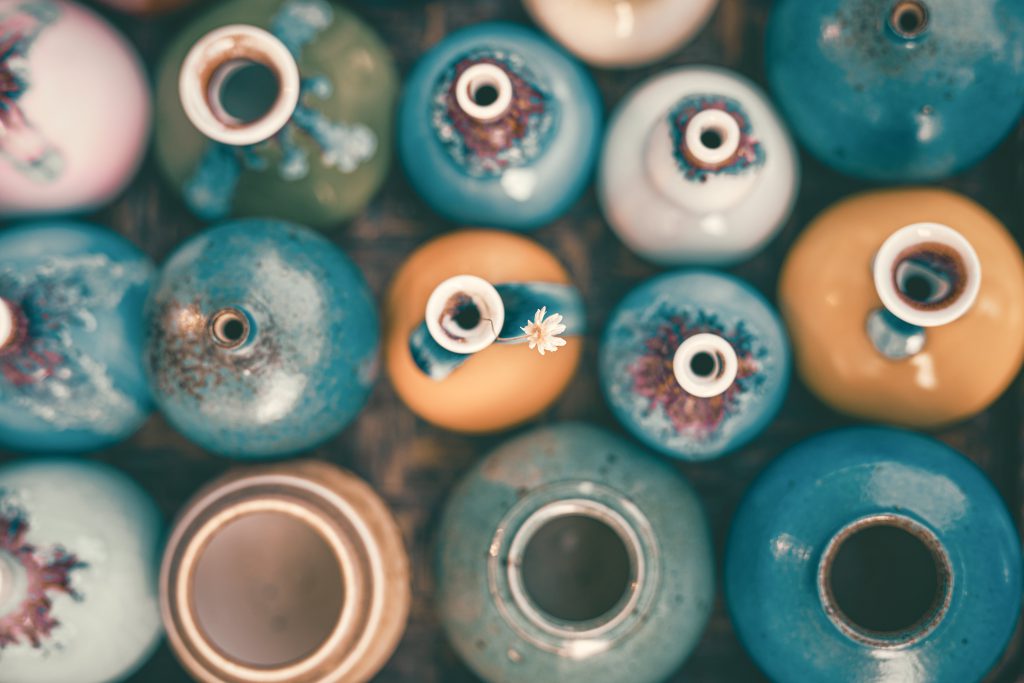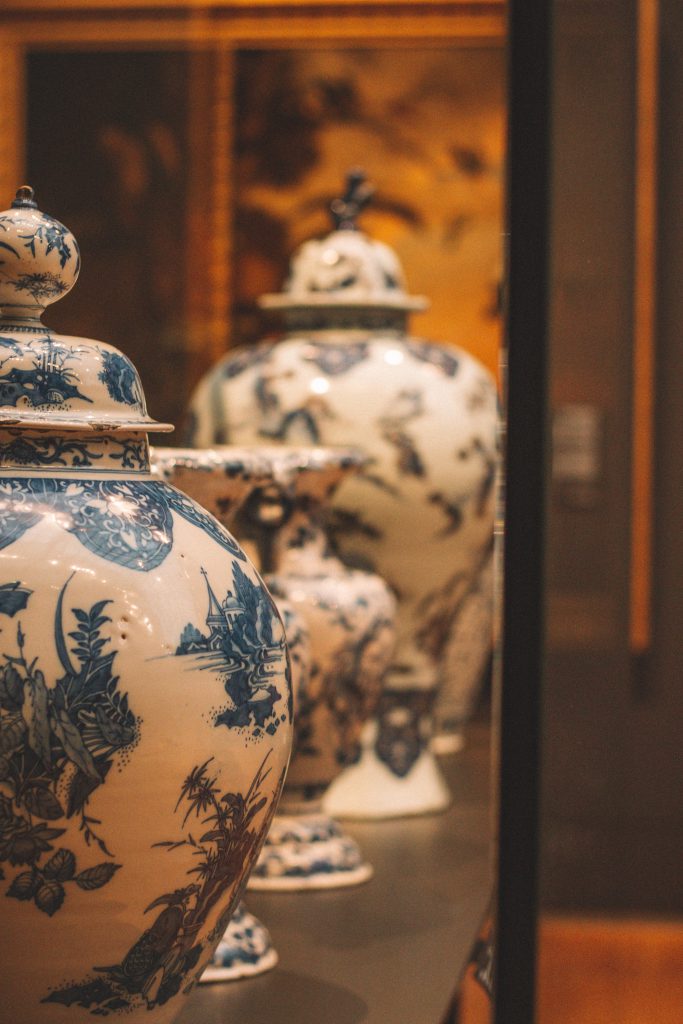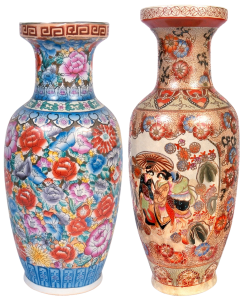
Antique vases are more than just decorative objects. They’re fascinating time capsules that preserve the beauty and history of past cultures. Antique vases come in all shapes, sizes, and designs, each with its unique story.
However, identifying whether a vase is truly antique or just a reproduction can be daunting, requiring a keen eye and extensive knowledge of antiques.
But fear not because we are here to guide you through the process of identifying antique vases and uncovering their distinguishing characteristics and hidden antique marks.
So, get ready to embark on an exciting journey into the world of genuine antique vases and unravel the mysteries of these ancient works of art!
General Tips for Identifying Antique Vases

If you’re searching for antique vases and wondering how to identify them, here are some general things to keep in mind that can help you distinguish between an authentic antique and a modern replica.
Age and Provenance
Determining the age of an antique vase is the foundation of the identification process. And factors such as provenance (history of ownership) can provide valuable clues.
Key indicators of age and provenance include:
- Maker’s marks
A vase’s markings, often found on the base of the vase, reveal the manufacturer or artist who made the piece. Researching these marks helps in determining the vase’s age and origin.
One example of a famous maker’s mark for an antique vase is the “KPM” sign, that stands for “Königliche Porzellan-Manufaktur” or Royal Porcelain Manufactory. This mark was used by the KPM factory in Berlin, Germany, founded in 1763, and is one of the oldest and most renowned porcelain factories in Europe.
- Historical records
Auction catalogs, museum records, and scholarly publications also provide insights into the age and provenance of antique vases.
To learn about the age and origins of antique vases, you can consult auction catalogs and museum records for information on previous sales, owners, and regions of origin. Scholarly publications, including art history books and academic journals, can also provide in-depth analysis of specific vase types and styles from different periods, assisting in determining their historical significance and value.
- Expert appraisals
Professional appraisers specializing in antiques are valuable assets when identifying a vase’s age and authenticity. They possess extensive knowledge of various vase types, materials, and styles across different periods.
They conduct thorough examinations of a vase’s condition to identify its age and detect any restoration work that may have been done. Professional appraisers may also use specialized tools and equipment to aid in determining a vase’s origin and age.
Materials and Manufacturing Techniques

Antique vases are typically crafted from porcelain, pottery, glass, and metal materials. Identifying the material used is a good indicator of the vase’s age and origin. Additionally, understanding historical manufacturing techniques can provide further insights.
Key factors to consider when examining the vase’s materials include:
- Porcelain and pottery
Examine the vase’s glaze, body, and decoration. Older vases may exhibit signs of hand-painted designs and uneven glazes, while newer pieces may have more uniform finishes and machine-printed patterns.
- Glass
Look for bubbles, striations, and imperfections in the glass, indicating that the vase was hand-blown – a common technique in antique glassware.
- Metal
Assess the metalwork for signs of hand-hammering or other handmade techniques suggesting an antique origin.
Style and Design
The style and design of a vase offer valuable clues to its age and origin. Familiarize yourself with historical and artistic movements, regional styles, and common motifs to better identify antique vases. Consider the following factors:
- Artistic movements
Research key periods in art history, such as Art Nouveau, Art Deco, and Arts and Crafts, to recognize design elements associated with these eras.
For example, Art Nouveau vases frequently incorporated innovative techniques, such as using pâte de verre (glass paste) or applying enamel over a textured surface to create a three-dimensional effect. The designs on Art Nouveau vases are often asymmetrical, and the overall effect is one of natural elegance and grace.
- Regional styles
Study the stylistic differences between regions, such as Chinese, Japanese, or European ceramics, to identify the vase’s origin. A famous example of an antique Japanese vase is the Satsuma vase, which originated in Japan during the late 19th century. Satsuma vases are characterized by an ivory-colored base and intricate gold detailing, often featuring raised paste decorations.
- Motifs
Examine the vase’s decorative elements and motifs, as these may be indicative of specific periods or cultures.
An example of an antique vase with motifs is the Chinese Cloisonné vase, which was popular during the Ming and Qing dynasties. Cloisonné vases are characterized by their intricate designs, featuring brightly colored motifs separated by thin metal wires. Motifs often depict flora and fauna, such as flowers, birds, or dragons, and are set against a dark blue or black background.
Condition and Rarity
A vase’s condition and rarity can impact its value and help determine its authenticity. Keep the following factors in mind.
- Condition
Antique vases may show signs of wear, such as fading, crazing (fine cracks in the glaze), and minor chips. While some wear is expected, extensive damage or repairs decreases the piece’s value.
- Rarity
As we mentioned, some designs, patterns, or styles are very specific for certain historical periods and could be very rare, making them more valuable to collectors. Research the specific design or style to determine its rarity.
Consult the Experts
Consulting experts and reputable dealers will help you accurately identify antique vases. Experienced professionals provide invaluable guidance and insights into a vase’s age, provenance, and authenticity. Find reputable dealers, appraisers, and auction houses to assist you in your identification journey.
Nippon Mark

The Nippon mark has represented exceptional quality and craftsmanship for over a century, adorning the base of numerous antique vases. Since these are such exquisite works of art originating from the Land of the Rising Sun, they have become synonymous with Japan’s cultural identity and artistic heritage.
The Birth of the Nippon Mark
The emergence of the Nippon mark dates back to the late 19th and early 20th centuries, a time of rapid modernization and global market integration in Japan. The McKinley Tariff Act of 1890 played a pivotal role in its origin as it mandated that imported goods must bear their country of origin’s name.
Japanese porcelain manufacturers responded by marking their products with “Nippon,” the Japanese word for Japan. Subsequently, “Nippon” became a prominent identifier on antique vases produced from 1891 to 1921.
Styles and Techniques
The Nippon mark on antique vases is often accompanied by a diverse array of styles and techniques, reflecting the rich artistic heritage of Japan. Some of the most notable techniques include:
- Moriage
A raised, slip-decorative technique that uses clay to create intricate designs and patterns on the vase’s surface. Moriage is often applied in multiple layers, giving the finished piece a textured, three-dimensional appearance.
- Kutani
A style characterized by bold colors, typically red, green, and gold, with intricate, hand-painted designs. Kutani vases feature landscapes, birds, flowers, or scenes from Japanese folklore.
- Satsuma
A pottery style known for its cream-colored base and delicate, hand-painted designs. Satsuma vases often include intricate depictions of people, animals, and nature with gold accents.
Identifying and Assessing Value
Collectors should examine several key factors to determine the authenticity and value of a Nippon-marked vase.
- Markings
Authentic Nippon marks are typically hand-painted or stamped on the vase’s base. Look for antique marks that include the words “Hand Painted,” “Made in Japan,” or “Nippon,” accompanied by a company logo or signature.
- Quality
Genuine Nippon vases are known for their exceptional craftsmanship and intricate designs. Look for precise, hand-painted details, well-defined moriage, and consistent color application.
- Condition
The condition of the vase plays a significant role in its value. Chips, cracks, and repairs can diminish the value, while pristine examples command higher prices.
- Rarity
Some Nippon vase designs and styles are rarer than others, making them more valuable to collectors. Collectors have a particular fondness for Nippon vases with hand-painted Moriage enamel. Researching the pattern or style can help determine its rarity and potential value.
Different Antique Vases Categories

Material-based Antique Vases
One way to categorize antique vases is by the materials used in their creation. The most common materials include porcelain, pottery, glass, and metal.
- Porcelain
Porcelain vases are characterized by their delicate, translucent quality and are often adorned with intricate hand-painted designs. Key features include a fine, white body and a glass-like surface. Notable examples of antique porcelain vases include Chinese famille rose and Japanese Imari ware.
- Pottery
Pottery vases are crafted from clay and are more opaque and heavier than porcelain. They often feature earthy tones and unique glazes. Examples include Greek amphorae, Chinese Yixing stoneware, and European majolica.
- Glass
Antique glass vases are prized for their diverse colors, patterns, and shapes. Look for signs of hand-blown glass, such as bubbles, striations, and uneven thickness. Prominent examples include Venetian Murano glass, French Art Nouveau glass by Emile Gallé, and American Tiffany glass.
- Metal
Metal vases are typically made from materials such as bronze, brass, or silver. They often feature intricate engraving, repoussé, or chased designs. Examples include Chinese cloisonné vases, Japanese mixed-metal vases, and Russian silver vases.
Region-based Antique Vases
Antique vases can also be categorized by their region of origin. Some well-known regional styles include:
- Chinese
Chinese antique vases often showcase vivid colors, intricate designs, and a variety of motifs, such as dragons, flowers, and landscapes. Key styles include blue and white porcelain, famille rose, and cloisonné.
- Japanese
Japanese antique vases are renowned for their refined craftsmanship and diverse styles. Look for motifs like cherry blossoms, cranes, or scenes from Japanese folklore. Some popular styles include Imari, Satsuma, and Kutani.
- European
European antique vases encompass various styles and materials, reflecting the continent’s diverse artistic heritage. Examples include French Art Nouveau glass, Italian majolica, and English Staffordshire pottery.
Artistic Movement-based Antique Vases
Recognizing antique vases based on the artistic movement they belong to can also identify their period and origin. Let’s review some significant artistic trends from the past.
- Art Nouveau (1890-1914)
Art Nouveau vases often feature sinuous lines, organic forms, and motifs inspired by nature. Notable examples include French cameo glass by Emile Gallé and Daum and Austrian Secessionist pottery by Michael Powolny.
- Art Deco (1920-1939)
Art Deco vases are characterized by geometric shapes, bold colors, and sleek, streamlined designs. Renowned examples include Clarice Cliff’s pottery, René Lalique’s glass, and Keith Murray’s Wedgwood ceramics.
- Arts and Crafts (1880-1920)
Arts and Crafts vases focus on craftsmanship, simplicity, and the use of natural materials. Examples include American Rookwood Pottery, British Martin Brothers Pottery, and French Grueby Faience Pottery.
Antique Chinese Vases

Historically, Chinese vases have been extremely popular, and collectors are always looking for them.
Let’s learn more about what makes these beautiful pieces special and unique and how to identify an antique Chinese vase.
A Brief History of Chinese Vases
China has a long history of ceramics that dates back thousands of years. The development of Chinese porcelain, a fine, translucent ceramic material, began during the Han dynasty (206 BCE – 220 CE) and reached its zenith during the Ming (1368-1644) and Qing (1644-1911) dynasties. Throughout this period, Chinese artisans refined their techniques and designs, producing functional vases emblematic of China’s cultural identity.
Key Styles and Techniques of Antique Chinese Vases
Many styles and techniques were employed in the creation of antique Chinese vases. Some of the most notable include:
- Blue and white porcelain
Characterized by cobalt-blue motifs painted on a white porcelain background, this style gained prominence during the Yuan (1279-1368) and Ming dynasties. The motifs often feature landscapes, flowers, or mythological creatures.
- Famille rose
The distinctive style of famille rose vases originated during the Qing dynasty and is characterized by its delicate enamel-painted designs in soft hues of pink, green, and yellow. Vases frequently feature intricate depictions of flowers, birds, and scenes from classical Chinese literature.
- Famille verte
Famille verte is a style of antique vases similar to famille rose, distinguished by vibrant green enamel and other vivid colors. Originating from the late Ming and early Qing dynasties, this style typically features intricate patterns and nature-inspired designs.
- Cloisonné
Cloisonné is a metalworking technique that involves applying colored enamel to a metal base, then separated by thin metal wires to create intricate designs. Cloisonné antique vases typically showcase vibrant depictions of flowers, birds, or dragons, and are recognized for their glossy finish and vivid colors.
Period-based Recognition

Antique Chinese vases may be identified by the historical period in which they were produced. Each period is associated with unique styles, techniques, and motifs. Familiarize yourself with the key periods in Chinese ceramic history to recognize and categorize antique vases:
- Tang Dynasty (618-907)
Known for its tri-color (sancai) glazed pottery, Tang Dynasty vases often feature earthy tones and simple, elegant shapes.
- Song Dynasty (960-1279)
During the Song dynasty, vases were celebrated for their refined ceramics, showcasing celadon and Ru ware and exhibiting understated, naturalistic forms and subtle glazes.
- Yuan dynasty (1271-1368)
Moving to the Yuan period, blue and white porcelain emerged, marked by cobalt-blue designs on a white background, often featuring flora, fauna, and mythical creatures.
- Ming Dynasty (1368-1644)
The Ming dynasty produced a plethora of porcelain styles, including blue and white, famille verte, and wucai. Vases from this era are celebrated for their intricate patterns, vivid colors, and depictions of Chinese mythology and history.
- The Qing dynasty (1644-1911)
The Qing dynasty witnessed the birth of several styles, such as famille rose, famille verte, and monochrome-glazed porcelain. Vases of this type are characterized by their intricate designs, enamel decoration, and intricate landscapes, leaving a long-lasting impression on collectors and enthusiasts alike.
Motif-based Recognition
Antique Chinese vases often feature recurring motifs that can provide valuable clues to their origins. Notable motifs include:
- Dragons and phoenixes
Mythological creatures symbolize power and good fortune, often appearing on imperial porcelain from the Ming and Qing dynasties.
- Flowers and plants
Floral motifs, such as peonies, chrysanthemums, and plum blossoms, are common on antique Chinese vases and can indicate specific periods or styles.
- Landscapes and architecture
Scenic depictions of mountains, rivers, and buildings are frequently found on blue and white porcelain and famille rose vases.
- Chinese characters and symbols
Calligraphy and auspicious symbols were also prominent aspects of antique Chinese vases, such as the bat (symbolizing happiness) and the Shou character (representing longevity).
Good Learning Resources

Are you looking to expand your knowledge about antique vases? We are sure some of these learning resources will help you on your learning journey.
Books
Books are a timeless and trustworthy source for those eager to explore the world of antique vases. With a wide array of literature available, from introductory guides to in-depth studies of specific periods, styles, or regions, there’s no shortage of fascinating reading material.
Some noteworthy titles include “Allen’s Antique Chinese Porcelain” by Anthony J. Allen, “Japanese Porcelain: 1800-1950” by Nancy Schiffer, and “American Art Pottery: Identification and Values” by Richard Sigafoose.
Online Communities
In the digital age, online communities are a great way to access a wealth of information and resources for antique vase enthusiasts. Forums and online discussion boards allow collectors and experts to share their knowledge and insights with others, as well as ask questions and seek advice.
Among the popular online communities for antique vases are Antiquers, Collectors Universe, and Asian Art.
Museums and Exhibitions
Visiting museums and exhibitions is an excellent way to view antique vases up close and learn about their history, styles, and techniques. Many museums have extensive collections of antique vases, and exhibitions offer a chance to view rare or unique pieces that may not be displayed at other times.
Some notable museums and exhibitions include the Metropolitan Museum of Art in New York City, The British Museum in London, and the Asian Art Museum in San Francisco.
Auctions and Antique Shows
Attending auctions and antique shows also provide valuable learning experiences for antique vase enthusiasts. Auctions offer an opportunity to see various pieces up for sale and observe the bidding process, while antique shows provide a chance to browse and compare different vases from multiple dealers.
Some popular auction houses include Christie’s and Sotheby’s, while antique shows can be found across the world, such as the International Ceramics Festival.
Professional Appraisers and Dealers
For more personalized and in-depth information, seeking out professional appraisers and dealers can be a helpful resource. Appraisers provide expert assessments of a vase’s age, origin, and value, while dealers offer guidance on purchasing, selling, or collecting antique vases. Make sure to choose reputable and experienced professionals and research their credentials and reviews before seeking their services.
Conclusion
We hope you’ve enjoyed learning about the unique features and characteristics that make these objects fascinating and valuable.
By now, you’re armed with a wealth of knowledge that will enable you to identify and appreciate antique vases like a seasoned expert. You’ll be able to impress your friends with your newfound expertise and even discover some hidden gems in your own collection or at antique shops.
Remember, genuine antique vases are not just decorative objects; they are tangible pieces of history that tell stories of past civilizations and their artistic achievements.

Leave a Reply